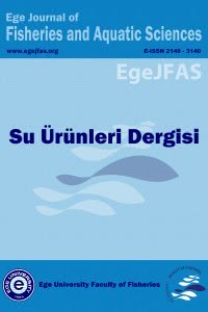Çanakkale boğazı ve Yöresinde İstilacı-Ekonomik bir gastropod Rapana venosa (Valenciennes, 1846): Biyoekolojisi ve avcılığı
ekoloji, balık avlama, deniz ekolojisi
An invader-economical gastropod Rapana venosa (Valenciennes,1846)in Çanakkale and adjacent regions
ecology, fishing, marine ecology,
___
Bilecik, N. 1990. Distribution of veined wheik Rapana venosa (Valenciennes, 1846) in Black Sea Coasts and Its effects on Black Sea Fisheries. 1846) TOKB Fisheries Research Insitute . Volume. No.1, BODRUM, p.34 (In Turkish)Demirci, G. 2005. Studies of Mollusca Fauna in Mid Black Sea, Türkiye. Fırat Üniv. Fen. ve Müh. Bil. Der. 17(3): 565-572. (in Turkish)
Düzgüneş, E., S. Ünsal,, M. Feyzioğlu, 1992. Stock Assessment of veined whelk Rapana themasiana (Gross, 1861) in Eastern Black Sea. Project number. DEBAG 143/G. p.55, KTÜ, Sürmene Marine Sciences Faculty. (In Turkish)
Georgiava, D., D. Schwark, P. Nikolov, K. Idekiava,, K. Parvanova, K. Dierks, N. Genov and C. Betzel, 2005. Conformational States of the Rapana themasiana Hemocyanin and Its substructures Studied by Dynamic Light Scattering and Time-Resolved Fluorescence Spectroscopy. Biophys J. 2005, February, 88 (2): 1276-1282.
Ghisotti, F. (1974). Rapana venosa (Valenciennes), nuova ospite Adriatica? Conchiglie, Milano 10:125-126.
Kerckhof, F„ R.J. Wink, D.C. Nieweg, and J.N. Post, 2006. The Veined Wheik Rapana venosa Has Reached The North Sea. Aquatic Invasions. The Eurepean Journal of Applied Research on Biological Invasions in Aquatic Ecosystems. Volumel: Issue 1. pp. 35-37.
Koutsoubas, D. and E. Voultsiadou-Koukara, E. 1991. The Occurence of Rapana venosa (Valenciennes, 1846) (Gastropoda, Thaididae) in Aegean Sea. Bollettino Malacologico, 26:201 -204.
Mann, R. and J.M., Harding, 2003. Salinity tolerance of larval Rapana venosa. Implications for dispersal and establishment of an inviding predatory gastropod on the North American Atlantic Coast.Biol. BULL.204:96-103
Öztürk, M., M. Öztürk, 1993. Various trace metal levels of veined whelk Rapana venosa (Valenciennes, 1846). Tr. J.of Zool. 18,193-198.
Sağlam, H. 2004. Bioecology of veined whelk in Eastern Black Sea. (Rapana themasiana, (Gross, 1861) Proje no.99.117.001.5 KTÜ. Research Fund. (In Turkish)
Uyan, O., O. Aral, 2003. Larval development phases within eggcapsules of veined whelk (Rapana themasaina (Gross, 1861) Turkish Journal Zoology. 27:331-337.
- ISSN: 1300-1590
- Yayın Aralığı: 4
- Başlangıç: 1984
- Yayıncı: Aynur Lök
Küçük Menderes Nehri ölçüm ağı tasarımı ve su kalite değişkenlerinin irdelenmesi çalışması
Vildan GÜNDOĞDU, E. Yeşim ÖZKAN
Tekirdağ ili (Marmara Denizi) kıyı balıkçılığı ve sorunları
İzmir Körfezi (Ege Denizi) Urla Yöresinde trata balıkçılığı
İzmir Körfezi ihtiyoplanktonu (1974-2005) türleri
Comparision of Two thiobarbituric acid (TBA) method for monitoring Iipid oxidation in fish
BAHAR TOKUR, KORAY KORKMAZ, DENİZ AYAS
Hatice PARLAK, Ayşe ÇAKIR, MELTEM BOYACIOĞLU, Özlem Çakal ARSLAN
Süleyman BALIK, Hasan M. SARI, Selçuk BERBER
Devegeçidi baraj gölü'nün (Diyarbakır) Cladocera ve Copepoda (Crustacea) faunası
Littoral fauna of oligochaeta (Annelida) of Lake Eğirdir (Isparta)
Güneydoğu Marmara'da algarna ile karides avcılığında av kopozisyonu ve hedef dışı av
YUSUF KENAN BAYHAN, ERDOĞAN ÇİÇEK, Tarık ÜNLÜER, Mehmet AKKAYA
